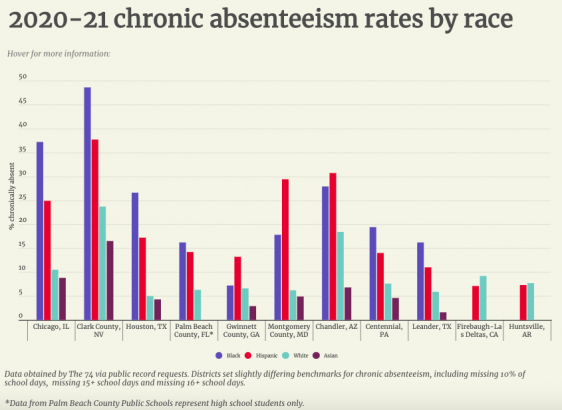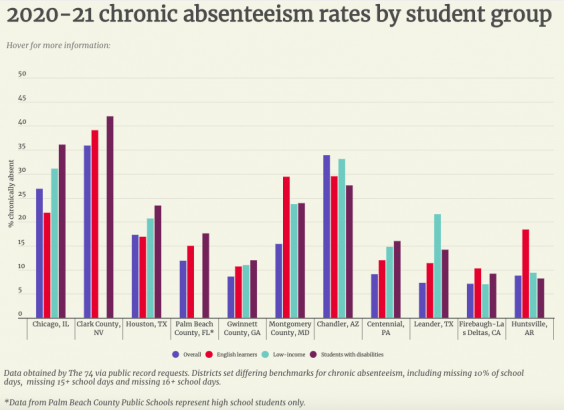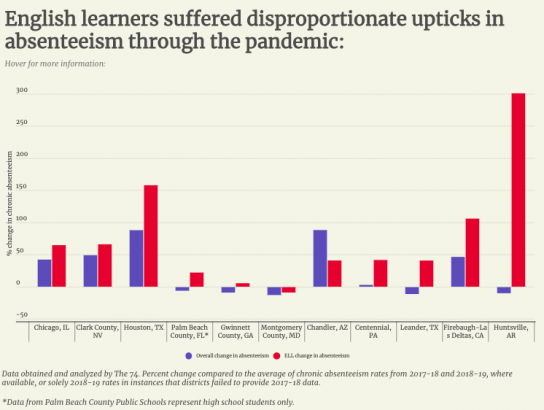Exclusive Data: Absenteeism Surged Among English Learners During Pandemic
“[School] was no longer our primary concern. We had to do anything to survive.”
By Asher Lehrer-Small | September 30, 2021When the pandemic struck, the shift to online learning marked an inauspicious turning point for Mia Miron, an English learner in Pomona, California.
Previously, she had almost never missed school. A doctor’s appointment here, a sick day there, but save for those rare occasions, she was always in class.
Her parents, immigrants from Mexico, had instilled in her a belief in the value of education as a path to a better life.

“School was one of my priorities,” the California teenager, now in eighth grade, told The 74.
But when COVID-19 forced instruction to move online, her absences began to rack up — sometimes due to a faulty laptop charger and sometimes due to her teachers failing to mark her present even when she had logged in, Miron said. Her grades fell from B’s and C’s to D’s and F’s.
Miron’s mother, Yosadara Carbajal, speaking through a translator, told The 74 that other families had experienced similar attendance problems, but when she raised the issue to school leaders in November 2020, they did not resolve the discrepancies. Pomona Unified School District, however, insisted that they maintained a lenient policy through remote learning toward parents vouching for their children’s attendance on Zoom and initiated multiple measures to re-engage disconnected students, including door-knocking and free one-on-one tutoring, which, as of this school year, Miron now receives.
Across the country, the obstacles posed by remote learning may have triggered a disproportionate jump in absenteeism among English learners like Miron, new data indicate, despite the 5 million student group having sported some of the highest rates of attendance nationwide before the pandemic compared to other learners.
Ten out of 11 school systems that provided data in response to public record requests filed by The 74 reported surges in chronic absenteeism among English learners in the 2020-21 school year. In all but one district, the percent change in absenteeism was higher among ELs than the overall student population.
For example:
● Chronic absenteeism among all 197,000 students in Houston increased 88 percent over the average rates for 2017-18 and 2018-19, but more than doubled — climbing 158 percent — among English learners.
● In Centennial School District in Pennsylvania, the overall absenteeism rate barely nudged upward, increasing just 2.8 percent, while the share of English learners missing a critical mass of classes jumped 42 percent.
● In an especially severe case, the rate of chronic absenteeism among all students in Huntsville School District in Arkansas dropped off slightly while the rate for English learners increased more than four fold.
“The pandemic hit immigrant families very, very hard,” Xilonin Cruz-Gonzalez, deputy director of Californians Together, a coalition that advocates for English learners in the Golden State, told The 74.
When the restaurant where Miron’s father worked closed due to COVID last year, her family was without its primary source of income. They launched a business selling sweet breads over Instagram as a way to bring in some cash.
“[School] was no longer our primary concern. We had to do anything to survive — to pay bills, rent, everything, before anything else,” said Carbajal.
But despite the disruption, the middle schooler was lucky: She had the WiFi and devices that she needed for remote learning, save for a finicky charger. She also speaks English confidently, although her school has not yet re-classified her out of English learner courses.
Many other English learners over the past 18 months, however, have lacked devices, juggled child care duties and struggled to navigate English-only instructions for platforms like Google Classroom or Zoom, according to reports through the pandemic. Still, COVID-19’s full impact on this vulnerable population has remained blurry.
With finalized nationwide counts of chronic absenteeism from last year still not expected for up to three months, these new figures offer a sneak peak into long-awaited data that helps bring the picture into clearer focus.
Students are typically defined as chronically absent when they miss more than 10 percent of school days, a benchmark for the typical 180-day school year that researchers say determines whether students have lost so much instruction that they may be academically at risk. Missed school days predict academic difficulties such as trouble reading in third grade, lower grades in middle school and higher dropout rates in high school.
The 74 requested absenteeism data from 30 districts nationwide, including the largest school systems and a sample of randomly selected suburban and rural districts. Some, such as New York City and Douglas County, Colorado, had not yet finished compiling absences and a handful, including Hillsborough County, Florida, were non-responsive. But 13 districts fulfilled the request, including 11 that delivered data disaggregated by factors including race, income, disability and English learner status.
The increased share of English learners missing class may reflect a breakdown in schools’ communication with non-English speaking families through the pandemic, said Melissa Castillo, Arizona associate state superintendent of diversity, equity, and inclusion.
“When we shut schools down, the challenge in communicating was taken to another whole level,” she told The 74.
The immigrant families Castillo works with are resilient and believe strongly in the value of education, she said. But with many lacking internet and devices, remote learning was very difficult.
“Schools weren’t equipped,” she added. “It was a structural issue.”
In the two rural districts in the sample, jumps in chronic absenteeism among English learners were especially pronounced, more than doubling in Firebaugh-Las Deltas, a rural district between Fresno and Salinas, California and more than quadrupling in Huntsville, Arkansas — likely reflecting a double disadvantage created by simultaneous linguistic and digital divides.
The Arkansas district did not have an explanation for the troubling pattern. Superintendent Audra Kimball wrote to The 74, “I don’t feel like I have enough knowledge … to give you an accurate answer.” She did not answer whether the district was aware of the high levels of absenteeism among English learners in the district before The 74’s inquiries.
Neither Houston ISD nor Centennial School District responded to The 74’s requests for comment on their disproportionate increases in English learners missing class.
Contrary to initial reports on absenteeism through the pandemic that have found stark increases in the share of students missing class, the numbers delivered to The 74 tell a story that’s less clean cut. Five out of the 13 districts actually reported small drops in overall chronic absence, but often with glaring differences between sub-groups. On top of jumps in the rate of English learners missing class, Black and low-income students tended to also have greater increases in absenteeism. White and Asian students often saw less severe jumps — and sometimes dips — in their rates.

“A student with ADHD might have found it easier to focus (during online learning) or a student with autism might have found it easier to interact with their educators,” Lindsay Jones, president and CEO of the National Center for Learning Disabilities, wrote in an email to The 74. “Now, we need to better understand what worked for the students who found remote learning easier or more engaging.”
Further patterns included elevated rates of absenteeism among younger learners. Although persistently missing school was much more common among high schoolers before the pandemic, some districts saw the pattern shift to younger grades during remote school, perhaps due to elementary schoolers struggling with Zoom when they lacked proper supervision.
In Miami-Dade County Schools, for example, which did not disaggregate their data by student group but did break down results by age, chronic absenteeism increased 6 percentage points among the district’s 110,000 elementary school students and 11 percentage points among its nearly 52,000 middle school students. It also increased 7 percentage points among its 101,000 high school students, but that jump represented a proportionally smaller increase due to higher pre-pandemic absence rates.

Chandler Unified School District in Arizona, the only school system in the dataset where proportional increases in chronic absenteeism were higher among the overall student body than among English learners, said differences in how attendance was coded for online versus in-person learners may have impacted the numbers. Districts also differed in whether they counted quarantined students as absent, whether they relied on families to proactively mark their kids present and whether webcams were a requirement for online learning.
“A lot fell through the cracks” in attendance counts last year, Paige Kowalski, executive vice president of the Data Quality Campaign, told The 74.
In districts where students missed less class last year than before the pandemic, Attendance Works Executive Director Hedy Chang worries that the numbers might tell a misleading story. During remote learning, it was often hard to tell whether students were truly engaged in class, especially when cameras were off.
“The data from last year masked, often, a loss of instructional time,” she told The 74.
In Gwinnett County Public Schools outside Atlanta, where about half of all 181,000 students learned remotely last year and chronic absenteeism fell roughly 1 percentage point below pre-pandemic levels, the reasons for the drop — and exactly what that reduction represents — remain unclear.
“We would just be guessing at this point,” admitted district spokesperson Bernard Watson. He did point out, however, that teachers worked hard to engage students, driving through young people’s neighborhoods during lockdown for socially distanced greetings.
But even in Gwinnett, as overall absenteeism trended downward, days of missed schooling among English learners ticked up. To re-engage those students, experts say schools need to be proactive in connecting with their families.
“Reach out in 10 different ways: texts, phone calls, home visits, flyers, direct mail — all the ways you can think of,” suggested Conor Williams, senior fellow at The Century Foundation and a frequent contributor at The 74. “Then once you make contact, ask… ‘What’s the best way to [stay] in touch with you?’”
A recent U.S. Department of Education study from Providence, Rhode Island supports this approach, finding that texts, calls and mentorship could chip away at absenteeism, although the data were collected before the pandemic. And last year, sending teachers door-to-door proved an effective — if labor-intensive — strategy to coax students back to class in districts across the country.
To mark the start of National Hispanic Heritage Month, a category to which more than three-quarters of English learners belong, the White House on Sept. 13 launched an all-new Hispanic education initiative to address the “systemic causes” of barriers to Latino achievement. It’s not yet clear how much the initiative will focus on English learners, who make up only about a quarter of the wider Latino student population in the U.S.
The U.S. Department of Education granted waivers for states’ 2019-20 federal data reporting requirements, but for 2020-21, the it’s requiring all states to publicly report disaggregated chronic absenteeism figures. Those numbers will likely be available by spring 2022, a department spokesperson told The 74.
As the Biden administration underscores the importance of a safe return to in-person school, many families of English learners feel trepidation about sending their children back into classrooms, said Rosario Quiroz Villarreal, policy director at The New Teacher Project. They, like any family, want to understand schools’ COVID safety protocols, especially because many live with older relatives, she explained, but oftentimes schools’ translation of these protocols can be lacking.
“It’s exclusion by omission,” the specialist on immigrant education told The 74.

In a school year already riddled by tens of thousands of student and staff quarantines, and as students no longer have the convenience of rolling out of bed and clicking into Zoom, researchers are worried there may be even more students missing class in 2021-22 — and not just English learners.
“We’re hearing about huge increases in chronic absenteeism in many of the districts that we’re speaking to,” said Chang, of Attendance Works. Oakland, California, for example, which publishes real-time data, has already seen the share of persistently missing students jump from 20 percent in 2020-21 to 33 percent so far this year.
“We’re going to have to really expand our personalized outreach and supports to families to make sure that their kids can get access to make up for whatever they lost,” said Chang.
Miron, in Pomona, is among the students who went back to in-person learning this fall, and her case underscores the importance of returning English learners to classrooms. Last year, she said, she “wasn’t really learning anything online.” But now that she has returned in person, “it’s a complete change for the better,” her mother reports. The teenager agrees.
“I feel like I’m actually learning something right now,” she said.
Editorial Fellow Marianna McMurdock contributed to this report.
Lead image: New data exclusive to The 74 show that English learners saw disproportionate surges in the rate at which they missed class during the pandemic. (John Moore/Getty Images)
Get stories like these delivered straight to your inbox. Sign up for The 74 Newsletter


